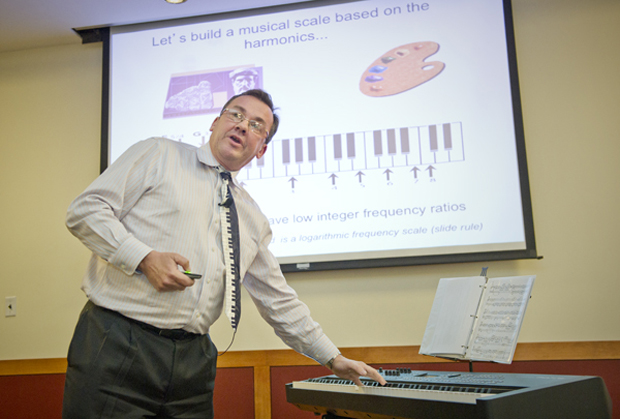The blues doctor is in the house

If members of the audience packing 318 Curry Student Center yesterday afternoon closed their eyes, they may have felt transported to a New Orleans blues bar — courtesy of the piano stylings of Murray Gibson, dean of the College of Science.
But that “bluesy” sound the audience heard does not arise naturally from a modern piano’s keys. It took centuries of literal fine-tuning to create the broad musical palette that characterized the playing of Jelly Roll Morton and ragtime legend Scott Joplin.
“Sound,” explained Gibson as he launched into a lecture entitled “Physics of the Blues” highlighting the origin of harmony and scales in Western music, “is a pressure wave hitting your ear.”
Each note Gibson played issued a wave vibrating at a characteristic frequency, along with all of its “harmonic” waves, or those vibrating exactly two, three, four times as fast. As he put it, “When two notes are played at the same time, if they have overlapping harmonics, they’ll sound consonant to your ear.”
Nearly 3,000 years ago Pythagoras constructed the first known scale from scratch, adding one note to the next whose wave frequencies had the ratio 3:2., known as a fifth. The resulting pentatonic scale consisted of the notes C, G, D, A and E, Gibson said. “In almost every civilization, this scale has emerged,” he explained. “You can play these notes in any combination and they will sound good together.”
Keep adding fifths, Gibson noted, and you get the classic diatonic scale we all remember from “The Sound of Music” (do, re, mi, fa, sol, la, ti). The problem with this approach is that if you continue to add perfect fifths, you will never join Maria back at “do.”
After seven notes, you are within one percent of the original frequency. To get closer, Gibson said, you must add another 22 notes — far too unwieldy for the human musician. So, we settled on a seven-note scale and that sufficed for a few millennia.
Then, 400 years ago, Bach was born. At the time, if pianos were tuned to the key of D, songs composed in the key of E sounded terrible. But Bach wanted more complexity in his compositions and a broader palette with which to shift between keys inside a single fugue or cantata. To overcome the need to re-tune his instrument mid-song, a new “well-tempered” scale emerged. Originally perceived as “the Devil’s scale,” it required each key to be out of tune by the same small amount.
“Together they sound okay, because they are all equally out of tune,” Gibson said.
But this tempering left out an important note — the blue note. Centuries after Bach, Morton and his contemporaries wanted to bring African sounds into Western music using the existing scale. In the key of C, the blue note resides somewhere between E flat and E, where no piano key exists. To get there, the original blues pianists invented the technique of “crushing” notes together — playing E flat and E simultaneously. Crushing was “an effort to get at a note that is missing from our sophisticated Western scale,” Gibson said.
“It created in its own way, a very rich, complex, and interesting musical genre which is unique to this situation,” he explained. “It wouldn’t be the same if the keyboard were to have the right note.”
Gibson assured his audience that he wasn’t trying to deconstruct music. Instead, he said, he wanted to emphasize the commonalities “between the physics and mathematics that drive it and the creation and interpretation of music.”
The brain, he added, must be using some of this when we sit back and listen to the blues.




